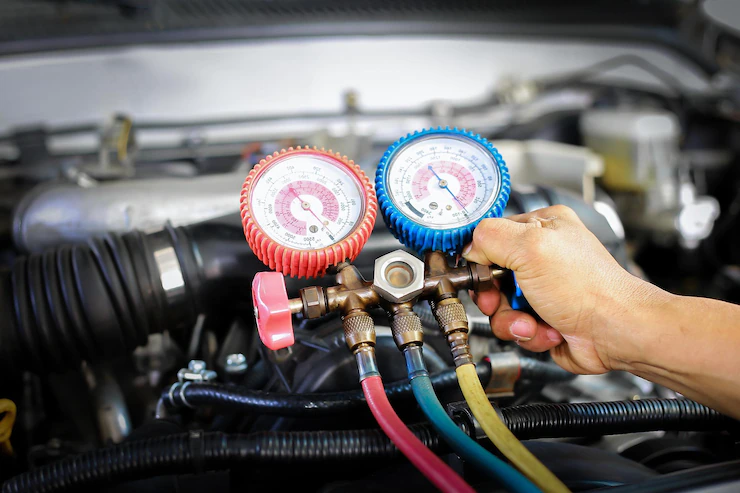Types Of Air Compressors And How To Maintain Them
by Sumona Technology Published on: 02 November 2022 Last Updated on: 04 November 2022

There are many different types of air compressors.
Between positive displacement compressors and turbo (or roto-dynamic) compressors, there are a bunch of different ones, all meant for slightly different purposes.
In this article, we’re going to be looking at the various type of air compressors and what they excel in. Whatever purposes you may be getting air compressor rentals or buying, the first thing you must know is what types of compressors are going to be suitable for you.
Generally, a commercial air compressor is categorized based on the pressure it delivers.
| 1. Those that produce a pressure of 150 pounds per sq. in. (10 bar) or less are called low-pressure air compressors or LPACs. 2. Compressors that can discharge pressure between 151 and 1,000 pounds per sq. in. (10.4 to 68.9 bar) are dubbed medium-pressure compressors. 3. Lastly, air compressors that can discharge over 1,000 pounds per sq. in. or 69 bar are called high-pressure air compressors (HPACs). |
2 Types Of Air Compressors And Their Maintenance
Different air compressors are built with different use cases in mind, and their parts differ too. That’s why repairing and maintaining one with the parts from another can be a struggle.

Air compressor parts need to be of the right type for any repair work to succeed.
A. Positive Displacement Compressors
The vast majority of commercial air compressors are positive displacement compressors. This is a method where the air is forced inside a chamber, which then reduces in size (in volume to effectively “compress” the air).
Once the chamber reaches its limit, it’s ready to go. A small outlet is opened via a valve to discharge the air as a stream out of the chamber.
Depending on the main part utilized, positive displacement air compressors are further subdivided into three categories:

1. Piston-Based Air Compressors
This is the most popular type of air compressor in the world. It gets its name from the fact that pistons constantly move to do the “pushing in” part where the air is forced inside the chamber.
Based on the delivered power, there are two kinds of these compressors.
● Single-stage piston air compressor: These are usually 1-5 horsepower.
● Two-stage piston air compressor: These are 5-30 horsepower and are most common for commercial applications and small businesses.
The piston-based air compressor uses a one-way valve to push air in and out of the chamber. The upstroke forces air out of the chamber into a storage tank, and the downstroke draws the air inside the chamber.
2. Rotary-Screw Air Compressors
Rotary-screw air compressor is for heavier-duty work, such as chillers, jackhammers, and impact wrenches. They replace piston-based air compressors, which we talked about in the previous section, in industrial applications that require a more powerful gas compressor.
The rotary-screw air compressor works with the help of twin screws. As these large, helical screws turn, the air is guided inside while the chamber’s size is reduced simultaneously.
● There are many types of rotary-screw air compressors in the range of 5-500 horsepower.
● As you go higher, you need much less space, tooling, and special care to run a rotary-screw compressor vis-à-vis a piston-based one (for example, a 200 horsepower piston compressor will need its separate staff, foundation, and rigging – whereas a 200 horsepower rotary-screw compressor can be placed normally on the floor).
3. Vane pumps
A Vane compressor or rotary vane pump is the third type of positive displacement compressor. They use a slotted rotor with blades to guide air inside the chamber and compress its volume. Often the vane pumps also have a pressure switch for air compressors.
A “vane” is a blade attached to a rotating axis that can be repositioned. The vanes in these compressors are sometimes adjustable in that you can individually set their tension or length to affect performance.
Vane pumps are mainly used for low-viscosity fluids for short periods of dry operation.
B. Roto-Dynamic/Turbo Air Compressors
Centrifugal and axial compressors make up the second major category of air compressors after positive displacement ones.
Typically, these compressors work by increasing the pressure by adding more energy to the flowing fluid.
Known for reducing operating costs and offering simpler manufacturing, these air compressors have fewer moving parts and are incidentally significantly more energy-efficient (lesser heat loss due to rubbing parts). Their higher non-oscillating constant stream is also preferred over the turbulent airflow of other compressors.

Wrapping up: Don’t Forget The Care!
No matter what type, size, and brand you go for – caring for your air compressor is a must. And good air compressor care begins with an oil level test and draining it properly.
To ensure that the correct amount of oil is being used in your compressor, you need to check the oil level regularly. You can use a dipstick to do this or simply look at the oil level in your compressor.
If you notice that it has dropped below a certain point, then you need to add more oil. This will ensure that there are no issues with your compressor as well as keep it running smoothly and efficiently.
Anyone who has owned an electric appliance before knows just how annoying it can be when they stop working because they have become clogged with dirt and debris. This can happen with air compressors, too, if not kept clean enough and maintained properly.
To prevent this, the first step is to drain out all of the old oil now. You have to check whether it isn’t clogged with junk inside it. You can do this either by removing the cover plate on top of your compressor or by opening up its side door where all of its essential parts are located.
We highly recommend learning more about air compressor maintenance before you buy a new one.
Additionals:







































































































